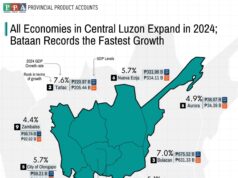SAN ISIDRO PENINSULA, Casiguran, Aurora – A ranking environment official expressed his concern over the unabated kaingin (slash-and-burn) farming here which threatens the remaining forestlands.
Benjamin Mina, provincial environment and natural resources officer (PENRO), said that the 12,800-hectare peninsula could lose its cover in five years should kaingeros, numbering about 800, and timber poachers continue to operate here.
He said that the more families come in, the more they would engage in the practice which could result in massive deforestation.
“If we allow people to come into the peninsula, then we will eventually see the forest cover in this area vanish completely in five years,” he said.
Another environment official, Alfredo Collado, community environment and natural resources officer (CENRO) for northern Aurora, said the area now being occupied by squatters used to be part of the Integrated Fort Management Agreement of the Industries Development Corp., one of the largest timber licensees in the province.
He said that the IDC plans to operate in the area starting in 2013 up to 2018.
But IDC eventually waived the area and excluded it from their operations.
Of the 12,800-hectare peninsula, some 3,000 hectares are considered virgin forests. Of these, 60 percent are classified as tenured area.
Collado said when the IDC abandoned the area, there was no one else protecting the area from the illegal activities of kaingeros, some of whom even set up coconut plantations. He said most of the kaingeros come from the adjoining towns of Casiguran and Dinalungan.
Collado said one of his men, Forester 3 Tony Aguilar who hails from Casiguran, recalled that when he settled in the peninsula in the 1960s, there was not a single family of informal settlers.
“He was surprised to find out that now, there are several informal settlers in the area,” he said.
Collado said the DENR is providing technical assistance to the Aurora Special Economic Zone Authority (Apeco) in the hiring and training of 19 Bantay-Gubat (forest guards) who will eventually be deployed to guard the shoreline in the San Isidro Peninsula.
He said it is up to Apeco to lobby for the declaration of the area as a protected area.
Benjamin Mina, provincial environment and natural resources officer (PENRO), said that the 12,800-hectare peninsula could lose its cover in five years should kaingeros, numbering about 800, and timber poachers continue to operate here.
He said that the more families come in, the more they would engage in the practice which could result in massive deforestation.
“If we allow people to come into the peninsula, then we will eventually see the forest cover in this area vanish completely in five years,” he said.
Another environment official, Alfredo Collado, community environment and natural resources officer (CENRO) for northern Aurora, said the area now being occupied by squatters used to be part of the Integrated Fort Management Agreement of the Industries Development Corp., one of the largest timber licensees in the province.
He said that the IDC plans to operate in the area starting in 2013 up to 2018.
But IDC eventually waived the area and excluded it from their operations.
Of the 12,800-hectare peninsula, some 3,000 hectares are considered virgin forests. Of these, 60 percent are classified as tenured area.
Collado said when the IDC abandoned the area, there was no one else protecting the area from the illegal activities of kaingeros, some of whom even set up coconut plantations. He said most of the kaingeros come from the adjoining towns of Casiguran and Dinalungan.
Collado said one of his men, Forester 3 Tony Aguilar who hails from Casiguran, recalled that when he settled in the peninsula in the 1960s, there was not a single family of informal settlers.
“He was surprised to find out that now, there are several informal settlers in the area,” he said.
Collado said the DENR is providing technical assistance to the Aurora Special Economic Zone Authority (Apeco) in the hiring and training of 19 Bantay-Gubat (forest guards) who will eventually be deployed to guard the shoreline in the San Isidro Peninsula.
He said it is up to Apeco to lobby for the declaration of the area as a protected area.




